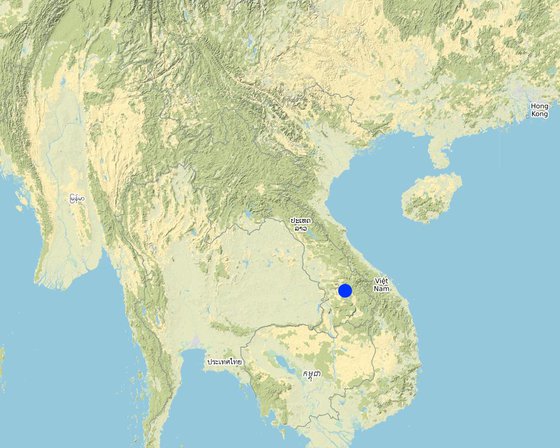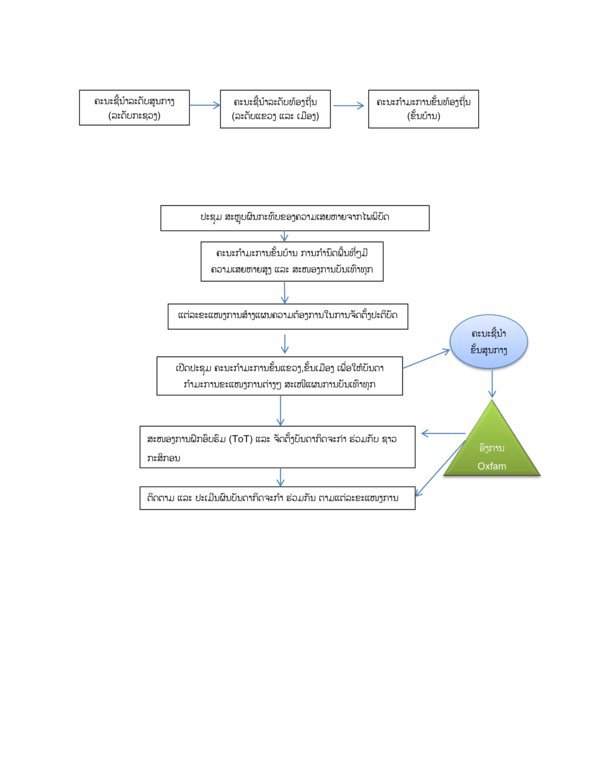The Upland Community Disaster Risk Reduction Project
(ลาว)
คำอธิบาย
The disaster risk reduction project in upland communities aims to increase understanding about disaster management, disaster risk reduction, and community resilience. The main activities include emergency response during floods/droughts, reduction of impacts from disease outbreaks, livestock revolving funds, and village rice banks.
The disaster risk reduction project in upland communities was established after the Ketsana typhoon hit the southern region of Lao PDR in 2008, causing significant losses to assets, infrastructure, and agricultural land. The project was approved by the Ministry of Labour and Social Welfare, and Ministry of Planning and Investment to be implemented at community level through a project steering committee which included the deputy provincial governor. The district governor was the project director at the local level based on an action plan developed by the ministries concerned with assistance from Oxfam Australia. This action plan was aimed at disaster prevention and control. The project coordinators came from the relevant government agencies including the District Labour and Social Welfare Office, the District Agriculture and Forestry Office, the District Administration Office, the District Health Office, the District of Natural Resources and Environment Office, and mass organizations (Women’s Union, Youth Union, Trades Union, and Lao Front for National Construction). The key project aims are to increase understanding about disaster management, disaster risk reduction, and community resilience. The main activities to be implemented include emergency response during floods/droughts, reduction of impacts from disease outbreaks, livestock revolving funds, and village rice banks. In the agriculture sector, the project promotes integrated crop cultivation (maize, beans, lemons, etc), a particular rice planting method termed SRI (System of Rice Intensification), and household gardens. In addition, Oxfam Australia and the local government of Lao PDR in cooperation with Care International (Xekong Province), and the World Food Programme provided emergency response and relief, and sanitation. Although there are a number of organizations which have contributed to disaster risk reduction and emergency response, constraints remain such as the implementation of limited life projects, inadequate funding, and a lack of coordination in the province and districts.. Village Committees for Disaster Prevention and Control have been established with regular meetings and disaster awareness campaign activities implemented. The project outcomes demonstrated that the communities are satisfied with their active participation.
สถานที่

สถานที่: Taouy district, Saravan province, ลาว
ตำแหน่งทางภูมิศาสตร์ของสถานที่ที่ถูกเลือ
วันที่ริเริ่ม: 2008
ปีที่สิ้นสุด: 2014
ประเภทของแนวทาง
-
แบบดั้งเดิม/ แบบพื้นเมิอง
-
เป็นนวัตกรรมท้องถิ่นล่าสุด/ นวัตกรรมใหม่
-
ใช้โครงงานหรือแผนงานเป็นฐาน

The former board of the community involved in implementation of the project (Anousit Namsena)
แนวทางการดำเนินการและบรรยากาศการพัฒนาที่เอื้ออํานวย
เป้าหมายหรือวัตถุประสงค์หลักของแนวทาง
The objectives of the project are to increase understanding about disaster management, disaster risk reduction, and community development in disaster impacted areas.
เงื่อนไขที่เอื้ออำนวยต่อการนำเอาเทคโนโลยีภายใต้แนวทางนี้ไปปฏิบัติใช้
-
บรรทัดฐานและค่านิยมทางสังคม วัฒนธรรม ศาสนา: Gender aspect – the project changed immoral traditional and cultural beliefs of people by encouraging men to have more involvement in household activities with women.
-
การมีไว้ให้หรือการเข้าถึงแหล่งการเงินและบริการ: Provide greater opportunities to vulnerable households to participate in the project, encourage local communities to access finance and animals for their own operations.
-
การจัดตั้งระดับองค์กร: Established the district and village committees levels in order to support the construction and administration work.
-
การร่วมมือหรือการทำงานประสานกันของผู้ลงมือปฏิบัติ: Regular collaboration with various levels including provincial, district and village.
-
ตลาด (จัดซื้อปัจจัยนำเข้า ขายผลิตภัณฑ์) และราคา: Set up the Chinese pear selling group
เงื่อนไขที่เป็นอุปสรรคต่อการนำเอาเทคโนโลยีภายใต้แนวทางนี้ไปปฏิบัติใช้
-
บรรทัดฐานและค่านิยมทางสังคม วัฒนธรรม ศาสนา: The two different farmer’s groups in the village do not want to work together - including on establishment of village rice banks and water borehole drilling.
การมีส่วนร่วมและบทบาทของผู้มีส่วนได้เสีย
ผู้มีส่วนได้เสียที่เกี่ยวข้องในแนวทางนี้และบทบาท
| ผู้มีส่วนได้เสียหรือองค์กรที่นำไปปฏิบัติใช้มีส่วนเกี่ยวข้องกับแนวทางนี้อย่างไร |
ระบุผู้มีส่วนได้ส่วนเสีย |
อธิบายบทบาทของผู้มีส่วนได้ส่วนเสีย |
| ผู้ใช้ที่ดินระดับท้องถิ่นหรือชุมชนระดับท้องถิ่น |
Farmer’s group |
Implementer |
| องค์กรที่ขึ้นอยู่กับชุมชน |
Village authorities and village organisation |
Approve, certify and dissemination of key information |
| ผู้เชี่ยวชาญ SLM หรือที่ปรึกษาการเกษตร |
District Agriculture and Forestry Office staffs |
Supervise the project implementation and provide training |
| องค์กรพัฒนาเอกชน |
Oxfam Project Staffs |
Supervise the project implementation and provide training |
| รัฐบาลระดับท้องถิ่น |
Provincial Agriculture and Forestry Office and District of Agriculture and Forestry Office staffs |
Leading, monitoring the implementation of the project and provide training |
| รัฐบาลแห่งชาติ (ผู้วางแผน ผู้ทำการตัดสินใจ) |
Central Administrative Office in Vientiane and Ministries level. |
Consultaition and approve the project implementation at national level. |
| องค์การระหว่างประเทศ |
Oxfam International Office |
Financial support |
การเกี่ยวข้องของผู้ใช้ที่ดินระดับท้องถิ่นหรือชุมชนระดับท้องถิ่นในช่วงต่าง ๆ ของแนวทาง
ไม่มี
ไม่ลงมือ
จ่ายเงินหรือสนับสนุนจากภายนอก
ปฏิสัมพันธ์
ระดมกำลังด้วยตนเอง
การติดตามตรวจสอบหรือการประเมินผล
Field exchange
Facilitate 20 staff and training on disaster management and
7 farmers from each village conducted the field exchange on rice production technologies.

ผู้เขียน Pasalath KHOUNSY
การตัดสินใจในการเลือกใช้เทคโนโลยี SLM
การตัดสินใจถูกทำโดย
-
ผู้ใช้ที่ดินเพียงผู้เดียว ( ริเริ่มด้วยตัวเอง)
-
ผู้ใช้ที่ดินเป็นผู้ตัดสินใจหลัก โดยการสนับสนุนจากผู้เชี่ยวชาญ SLM
-
ผู้ลงมือปฏิบัติที่เกี่ยวข้องทั้งหมดในฐานะที่เป็นส่วนรวมของแนวทาง
-
ผู้เชี่ยวชาญ SLM เป็นผู้ตัดสินใจหลัก ที่ติดตามให้คำปรึกษากับผู้ใช้ที่ดิน
-
ผู้เชี่ยวชาญ SLM เพียงผู้เดียว
-
นักการเมืองหรือผู้นำ
การตัดสินใจถูกตัดสินอยู่บนพื้นฐานของ
-
การประเมินความรู้ SLM ที่ได้ทำการบันทึกไว้เป็นอย่างดี (การใช้ข้อมูลในการตัดสินใจ)
-
สิ่งที่ค้นพบจากงานวิจัย
-
ประสบการณ์และความคิดเห็นส่วนตัว (ไม่ได้ลงบันทึกไว้)
การสนับสนุนด้านเทคนิค การสร้างขีดความสามารถ และการจัดการด้านความรู้
กิจกรรมหรือการบริการต่อจากนี้เป็นส่วนหนึ่งของแนวทาง
-
การสร้างขีดความสามารถ / การอบรม
-
การบริการให้คำแนะนำ
-
การเสริมความแข็งแกร่งให้กับสถาบัน (การพัฒนาองค์กร)
-
การติดตามตรวจสอบและประเมินผล
-
การวิจัย
การสร้างสมรรถภาพหรือการอบรม
การจัดอบรมถูกจัดขึ้นสำหรับผู้มีส่วนได้ส่วนเสียต่อไปนี้
-
ผู้ใช้ที่ดิน
-
เจ้าหน้าที่ภาคสนาม / ที่ปรึกษา
รูปแบบของการอบรม
-
กำลังดำเนินการ
-
เกษตรกรกับเกษตรกร
-
ใช้พื้นที่ทำการสาธิต
-
จัดการประชุมสู่สาธารณชน
-
จัดคอร์ส
หัวข้อที่อบรม
The fund management, water supply uses, rice bank, veterinary, chicken raising, aquaculture, rice production, disaster risk preparedness and response, typhoon, forest fires, disaster warning equipment.
การบริการให้คำแนะนำ
การให้คำแนะนำถูกจัดขึ้น
-
ไปเยี่ยมชมสถานที่
-
ที่ศูนย์ถาวร
Once per month
การสร้างความแข็งแกร่งให้กับองค์กร
องค์กรถูกทำให้แข็งแกร่งขึ้นหรือจัดตั้งขึ้น
-
ไม่
-
ใช่ เล็กน้อย
-
ใช่ ปานกลาง
-
ใช่ อย่างมาก
อธิบายถึงสถาบัน บทบาทและความรับผิดชอบ สมาชิก เป็นต้น
The district and village committees for disaster prevention and control are responsible for supervising, acting as focal points and reporting to the provincial and central levels.
ประเภทของการให้ความช่วยเหลือสนับสนุน
-
ด้านการเงิน
-
การสร้างขีดความสามารถ / การอบรม
-
อุปกรณ์
รายละเอียดเพิ่มเติม
การติดตามตรวจสอบและประเมินผล
The M&E team of the Oxfam project organized a monthly monitoring meeting involving collaboration with the community board at village and district levels.
การวิจัย
การวิจัยกระทำกับหัวข้อต่อไปนี้
-
สังคมวิทยา
-
เศรษฐศาสตร์หรือการตลาด
-
นิเวศวิทยา
-
เทคโนโลยี
A number of potentially appropriate activities have been modified to fit local conditions, such as: promotion economics / marketing of animal breeds that people never raised before.
การสนับสนุนด้านการเงินและวัสดุอุปกรณ์
งบประมาณประจำปีสำหรับองค์ประกอบ SLM เป็นจำนวนดอลลาร์สหรัฐ
-
< 2,000
-
2,000-10,000
-
10,000-100,000
-
10,000-100,000
-
> 1,000,000
Precise annual budget: 100000.0
AUSAid funding source
การบริการหรือแรงจูงใจต่อจากนี้ได้ถูกจัดให้สำหรับผู้ใช้ที่ดิน
-
การสนับสนุนด้านการเงิน / วัสดุอุปกรณ์ให้แก่ผู้ใช้ที่ดิน
-
เงินสนับสนุนสำหรับปัจจัยการผลิต
-
เครดิต
-
แรงจูงใจหรือเครื่องมืออื่น ๆ
การสนับสนุนด้านการเงินและวัสดุอุปกรณ์ให้แก่ผู้ใช้ที่ดิน
Financial supported by AUSAid and implemented by Oxfam Australia
ได้รับการช่วยเหลือทางการเงินบางส่วน
ได้รับการช่วยเหลือทางการเงินแบบเต็ม
แรงงาน
local communities supplied labor and the project paid for this
วัสดุสำหรับการก่อสร้าง: หิน
วัสดุสำหรับการก่อสร้าง: หิน: ไม้
Villagers
โครงสร้างพื้นฐาน: ถนน
Project
โครงสร้างพื้นฐาน: ถนน: โรงเรียน
Project
แรงงานของผู้ใช้ที่ดินคือ
-
สมัครใจ
-
อาหารสำหรับการทำงาน
-
จ่ายเป็นเงินสด
-
ให้ค่าตอบแทนด้วยการสนับสนุนด้านวัสดุอุปกรณ์อื่น ๆ
ผลกระทบและสรุปคำบอกกล่าว
ผลกระทบของแนวทาง
ไม่ใช่
ใช่ เล็กน้อย
ใช่ ปานกลาง
ใช่ อย่างมาก
ทำให้ผู้ใช้ที่ดินระดับท้องถิ่นมีอำนาจขึ้น ปรับปรุงการเข้าร่วมของผู้มีส่วนได้ส่วนเสียให้ดีขึ้นหรือไม่
ช่วยในการตัดสินใจโดยดูจากหลักฐาน ได้หรือไม่
ช่วยให้ผู้ใช้ที่ดินนำเอาเทคโนโลยี SLMไปใช้และบำรุงรักษาสภาพไว้ได้หรือไม่
ปรับปรุงความร่วมมือกันและการดำเนิน งานของ SLM ได้อย่างมีประสิทธิผลหรือไม่
ระดมกำลังหรือปรับปรุงการเข้าถึงแหล่ง เงินทุนสำหรับการดำเนินการ SLM หรือไม่
ปรับปรุงความรู้และความสามารถของผู้ใช้ที่ดินในการดำเนินการ SLM หรือไม่
ปรับปรุงความรู้และความสามารถของผู้มีส่วนได้ส่วนเสียคนอื่น ๆ ให้ดีขึ้นหรือไม่
ทำให้ผู้ใช้ที่ดินระดับท้องถิ่นมีอำนาจขึ้น ปรับปรุงการเข้าร่วมของผู้มีส่วนได้ส่วนเสียให้ดีขึ้นหรือไม่
ช่วยบรรเทาความขัดแย้งหรือไม่
ทำให้กลุ่มด้อยโอกาสมีอำนาจทางสังคมและเศรษฐกิจหรือไม่
ปรับปรุงความทัดเทียมกันด้านเพศและให้อำนาจแก่ผู้หญิงและเด็กผู้หญิงหรือไม่
ส่งเสริมให้เยาวชนหรือบุตรหลานของผู้ใช้ที่ดินให้เข้าร่วมใน SLM
นำไปสู่ความมั่นคงด้านอาหารหรือปรับปรุงโภชนาการให้ดีขึ้น
ปรับปรุงการเข้าถึงตลาดหรือไม่
นำไปสู่การเข้าถึงเรื่องน้ำและสุขาภิบาลได้ดีขึ้นหรือไม่
ปรับปรุงความสามารถของผู้ใช้ที่ดินในการปรับตัวให้เข้ากับการเปลี่ยนแปลงของสภาพภูมิอากาศหรือสภาพที่รุนแรงและภัยพิบัติหรือไม่
The end of project, there is no follow up activity but some activity were went well especially for the rice bank.
นำไปสู่โอกาสในการจ้างงาน รายได้หรือไม่
Some people have learned from the project and gained useful knowledge and experiences which has enabled them to find other employment opportunities.
แรงจูงใจหลักของผู้ใช้ที่ดินเพื่อที่จะนำ SLM ไปปฏิบัติใช้
-
การผลิตที่เพิ่มขึ้น
-
กำไร (ความสามารถ) อัตราส่วนค่าใช้จ่ายต่อผลประโยชน์ที่เพิ่มขึ้น
-
การเสื่อมของที่ดินลดลง
-
ความเสี่ยงของภัยพิบัติลดลง
-
ภาระงานลดลง
-
การจ่ายเงินหรือการช่วยเหลือ
-
กฎและระเบียบ (ค่าปรับ) หรือการบังคับใช้
-
เกียรติภูมิ แรงกดดันทางสังคม ความเชื่อมแน่นทางสังคม
-
การเข้าร่วมสมทบในขบวนการ โครงการ กลุ่ม เครือข่าย
-
จิตสำนึกด้านสิ่งแวดล้อม
-
ประเพณีและความเชื่อ ศีลธรรม
-
ความรู้และทักษะ SLM ที่เพิ่มพูนขึ้น
-
การปรับปรุงด้านสุทรียภาพ
-
การบรรเทาด้านความขัดแย้ง
ความยั่งยืนของกิจกรรมของแนวทาง
ผู้ใช้ปที่ดินสามารถทำให้สิ่งต่างๆ ที่ได้ปฏิบัติใช้โดยแนวทางนี้ยั่งยืนได้หรือไม่ (โดยไม่มีการสนับสนุนจากภายนอก)?
The rice production and animal breeding groups are able to maintain their initiatives. Gravity fed water supply system, school, road have been supported by other development organizations.
บทสรุปหรือบทเรียนที่ได้รับ
จุดแข็ง: มุมมองของผู้ใช้ที่ดิน
-
Project implementation plan is parallel with the district development strategy and meets the needs of local people.
-
Build understanding on project management, project coordination in each level.
-
Continuous project monitoring for approximately 3 – 5 years.
-
Mobilization for participation in activities.
จุดแข็ง: ทัศนคติของผู้รวบรวมหรือวิทยากรคนอื่นๆ
-
The project apply the participatory approach from early stage until monitoring phase.
-
Promotion of all concerned agencies and offices.
-
Detailed assessment for capacity building in planning for equipment/material supply, vehicles, staff visit the villages regularly.
จุดด้อย/ข้อเสีย/ความเสี่ยง: มุมมองของผู้ใช้ที่ดินแก้ไขปัญหาได้อย่างไร
-
The staff lack appropriate knowledge and skills
Provide more training on technical knowledges and skills and other relevant topics.
-
There is still a large gap to understanding on certain topics between officials and local communities.
On-the-job training, use video as a means for communication to increase local people’s understanding.
-
Dependency on project and government to implement activities.
-
Some immoral traditional and cultural beliefs are still hindering development efforts.
It is recommended to increase awareness of village elders who can then influence the local people.
จุดด้อย/ข้อเสีย/ความเสี่ยง: ทัศนคติของผู้รวบรวมหรือวิทยากรคนอื่นๆแก้ไขปัญหาได้อย่างไร
-
Lack of financial resources to monitor project activities.
-
There were issues with repayment to village development fund, animal revolving fund in order to rotate to other households.
The need to have a robust contract and revise regulations.
-
Delayed supply of materials which is impact to late activity implementation.
-
Hand over of responsibilities to persons with insufficient capability.
Consider to transfer the activity to local implementers.
การอ้างอิง
ผู้ตรวจสอบ
-
Nicole Harari
-
William Critchley
วันที่จัดทำเอกสาร: 17 ตุลาคม 2017
การอัพเดทล่าสุด: 11 มกราคม 2021
วิทยากร
-
Soukkaseum Malichanse (smalychansy@gmail.com) - ผู้ใช้ที่ดิน
-
Seuth Vilaysak - District steering committee
-
Boutsa Keokhamma - District steering committee
คำอธิบายฉบับเต็มในฐานข้อมูล WOCAT
การจัดทำเอกสารถูกทำโดย
องค์กร
- National Agriculture and Forestry Research Institute (NAFRI) - ลาว
โครงการ
- Scaling-up SLM practices by smallholder farmers (IFAD)






